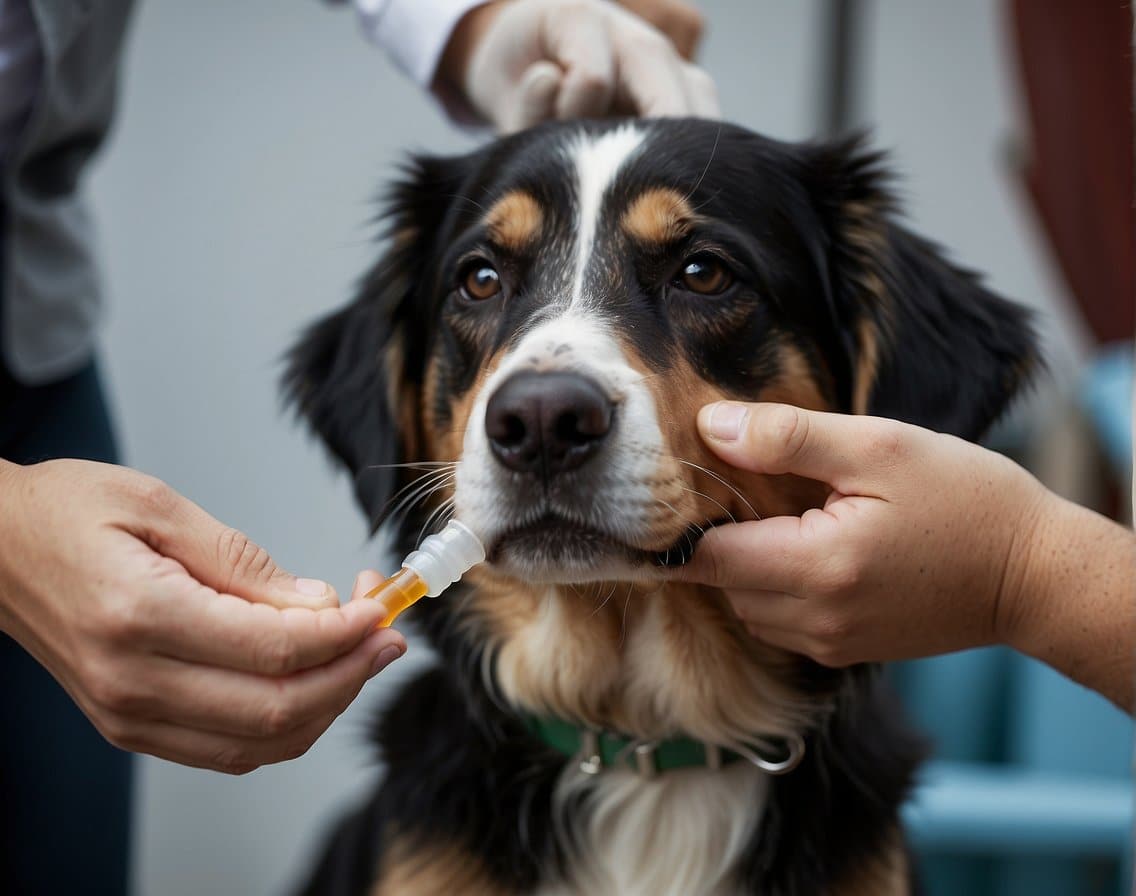
Diphenhydramine, commonly known as Benadryl, is a medication frequently used to treat allergy symptoms, and it’s not limited to humans—dogs can also benefit from its effects. The same properties that make Benadryl effective for relieving allergic reactions, such as itchiness, swelling, and hives in humans, apply to canines as well. Dog owners might reach for Benadryl to alleviate their pet’s discomfort from skin allergies, reactions to insect bites, or as a sedative in stressful situations.
Determining the correct dosage of Benadryl for a dog is crucial, as giving too little may be ineffective, and too much could cause adverse effects. The dosing often depends on the dog’s weight, with a general guideline provided by veterinary experts stating a range that should be adhered to. In any case, veterinarians emphasize the importance of consulting a professional before administering the medication to ensure it is the appropriate treatment for the dog’s specific condition.
Key Takeaways
- Benadryl is used to treat allergies and can serve as a mild sedative for dogs.
- Correct dosing is important and typically based on the dog’s weight.
- Consulting with a vet prior to administering Benadryl is strongly advised.
Understanding Benadryl
Benadryl is a widely recognized medication for treating various allergic reactions in dogs, which operates as an antihistamine featuring diphenhydramine as the active ingredient. This section delves into what diphenhydramine is, how Benadryl functions as an antihistamine, and the common uses of Benadryl when it comes to canines.
What Is Diphenhydramine?
Diphenhydramine is a first-generation antihistamine, which means it crosses the blood-brain barrier and can cause drowsiness. As the active ingredient in Benadryl, it counteracts the effects of histamine, a substance in the body that triggers allergic symptoms.
Benadryl as an Antihistamine
Benadryl serves as an antihistamine by blocking the uptake of histamine at the H1 receptor sites. Histamine is involved in immune responses to foreign pathogens, but its overactivity can lead to symptoms like itching, hives, and swelling. By preventing histamine from binding to its receptors, Benadryl reduces these allergic reactions.
Common Uses of Benadryl in Dogs
The most common use of Benadryl in dogs is for mitigating allergic reactions such as itchiness and inflammation. It’s also employed as a sedative due to its drowsiness-inducing effects, helping manage travel anxiety and motion sickness. Veterinarians might recommend it one hour before travel to help prevent nausea and vomiting. It’s essential, however, to consult with a veterinarian about the appropriate dosage for a dog’s specific needs and condition.
Safety and Precautions

When administering Benadryl to dogs, it is crucial to consider safety measures and be aware of potential risks to ensure the well-being of the pet. Adherence to proper dosage and understanding the impact of pre-existing health conditions can help mitigate any adverse effects.
Consulting a Veterinarian
Before giving a dog Benadryl, consulting a veterinarian is vital as they can provide a safe dosage recommendation based on the dog’s specific weight and health profile. A veterinarian can also determine if Benadryl is appropriate for the dog’s particular condition or if it might interact with other medications the pet is taking.
Health Conditions and Benadryl
Benadryl may not be safe for dogs with certain health conditions such as glaucoma, heart disease, hypertension, hyperthyroidism, or if the dog is pregnant. These conditions could be exacerbated by the effects of Benadryl, and alternative treatments may be necessary. Similarly, for dogs that have experienced previous allergic reactions to similar medications, Benadryl should be avoided unless a veterinarian advises otherwise.
Potential Risks and Side Effects
The administration of Benadryl can lead to a range of side effects in dogs, including:
- Dry mouth
- Hypersalivation
- Vomiting
In addition, while rare, more severe reactions such as seizures or coma could occur, particularly in the case of an overdose. Monitoring the dog closely after giving Benadryl for any signs of distress is important for the owner’s peace of mind and the animal’s safety.
Dosage and Administration

Proper dosage and administration of Benadryl are crucial to ensure the safety and efficacy of the medication for dogs. Factors such as the dog’s weight and the form of Benadryl are important considerations.
Calculating the Appropriate Dosage
The standard dosage of Benadryl for dogs is typically based on the dog’s body weight. Veterinarians commonly recommend administering 2-4 milligrams of Benadryl per kilogram of body weight. This translates to about 0.9 to 1.8 milligrams per pound. For example:
- A 10-pound dog would generally require between 9 to 18 milligrams of Benadryl.
Forms of Benadryl
Benadryl is available in various forms including:
- Tablets and Capsules: Usually available in a 25 mg size for adult-strength formulas.
- Liquid Benadryl: Often recommended for dogs weighing less than 10 pounds due to easier measurement of smaller doses.
It’s imperative to steer clear of time-release capsules as they may not be absorbed properly in a dog’s system.
Administering Benadryl to Dogs
When administering Benadryl:
- Tablets/Capsules: These can be given directly or hidden in food.
- Liquid Medication: Should be measured carefully using a syringe for accuracy.
Always consult with a veterinarian before administering Benadryl, as they can provide personalized advice and ensure it’s safe for your dog, especially if they are under the care of the FDA for other conditions.
Benadryl for Specific Conditions
Benadryl, known generically as diphenhydramine, is frequently used to manage various allergic conditions in dogs, ranging from environmental allergies to severe acute reactions. It also offers a sedative effect that can help with anxiety during travel.
Skin and Environmental Allergies
In cases of skin allergies or environmental stimuli that cause discomfort, dogs often suffer from itching, hives, and swelling. Benadryl is commonly administered to alleviate these symptoms. For conditions such as these, Merck Veterinary Manual suggests the following dosing guide:
- Initial Dose: 2-4 mg per kilogram of body weight
- Frequency: This dose can be given 2-3 times a day.
Note: It’s most effective when given before exposure to the allergen or at the onset of symptoms.
Severe Allergic Reactions
For more severe allergic reactions, such as intense swelling or hives, particularly those resulting from insect bites or stings, a timely dose of Benadryl can be critical. The aim here is to reduce the reaction’s severity and provide relief until veterinary help can be sought.
Warning: Severe reactions may require immediate professional medical intervention.
Anxiety and Travel-Related Issues
Benadryl’s sedative properties are not just for allergies; they also help manage anxiety and travel-related issues in dogs. When given approximately one hour before travel, it can help to reduce anxiety levels and motion sickness.
- Dosage for Travel Anxiety: Consult veterinarian as it may vary.
In every case, it is crucial to consult with a veterinarian to determine the appropriate dosage and assess the risks, especially for dogs with chronic health conditions or those on other medications.
Side Effects and Emergency Situations
When administering Benadryl to dogs, it’s essential to monitor them closely for any side effects such as vomiting, diarrhea, or drowsiness. Some reactions may require immediate attention from a veterinarian to ensure the safety and health of the pet.
Recognizing Adverse Reactions
- Vomiting/Diarrhea: If a dog begins to vomit or has diarrhea after taking Benadryl, these could be signs of an adverse reaction.
- Drowsiness: While drowsiness is a common side effect, excessive sleepiness can indicate an overdose.
- Agitation/Dilated Pupils: Uncharacteristic agitation or noticeably dilated pupils are cause for concern.
- Rapid Breathing/High Blood Pressure: Any changes in breathing patterns or signs of elevated blood pressure warrant a closer look.
When to Seek Immediate Care
- Severe Reactions: Should a dog exhibit seizures, extreme restlessness, or an increased heart rate, contact a veterinarian immediately.
- Anaphylaxis: In the case of severe allergic reactions indicated by facial swelling, hives, or difficulty breathing, visit the nearest veterinary medicine emergency facility.
- Existing Medical History: For dogs with a complex medical history, consult with a veterinarian prior to administering Benadryl, as it may interact with other medications or pre-existing conditions.
Considerations for Specific Dog Populations
When administering Benadryl to dogs, it’s essential to consider the age and health status of the pet, as puppies and senior dogs with pre-existing conditions may have different needs and potential risks.
Puppies and Benadryl
Puppies have developing bodies and immune systems that require careful consideration when administering medications. Due to their smaller size and the ongoing development of their organs, puppies may react differently to Benadryl compared to adult dogs. It is crucial to consult a veterinarian for the correct dosage, as the standard adult dosage could be too high for puppies. It’s also important to ensure that the medication does not interfere with vaccination schedules, as Benadryl can sometimes be used as a pre-treatment before vaccines.
Senior Dogs and Pre-Existing Conditions
Senior dogs often have a higher risk of health complications and may be taking other medications that could interact with Benadryl. For example, Benadryl must be used with caution in senior dogs with seizure disorders, as it can affect the central nervous system. Additionally, dogs with mast cell tumors can release histamine; since Benadryl is an antihistamine, it’s important to assess its use carefully under these conditions. A veterinarian should always be consulted to safely adjust the dosage for senior pets or those with any pre-existing conditions. It is critical to ensure Benadryl’s usage is safe and effective, considering the pet’s overall health.
Alternative Treatments and Therapies
When treating allergies in dogs, there are a number of alternative treatments and therapies to consider beyond the typical administration of Benadryl. These alternatives can range from holistic and natural options to other medications that may better suit certain dogs’ needs while addressing symptoms such as itching, redness, and inflammation.
Holistic and Natural Options
For dog owners seeking holistic and natural remedies for their pets’ seasonal allergies, Quercetin stands out as a powerful choice. Quercetin acts as both an antioxidant and an antihistamine, helping to reduce the inflammatory response in dogs. Similarly, omega-3 fatty acids, found in fish oil supplements, are touted for their anti-inflammatory properties, which can aid in controlling allergic reactions.
- Quercetin: A natural flavonoid with antihistamine and anti-inflammatory properties. (Allergies In Dogs: How Benadryl Or This Natural Alternative Could Help)
- Omega-3 Fatty Acids: Commonly found in fish oil, these acids can help reduce allergic symptoms.
Other Medications for Allergies
Aside from Benadryl, there are other medications that a veterinarian may recommend for a dog’s allergies. Cetirizine is an antihistamine used to combat symptoms of allergies, minus the lethargy commonly associated with Benadryl. Decongestants can also be employed, but with caution, primarily when nasal congestion is a significant concern. For more severe allergic reactions, gabapentin has been known to alleviate discomfort, particularly when itching causes excessive scratching or has a nervous component.
- Cetirizine: An antihistamine alternative for treating itchiness and skin irritation without causing drowsiness.
- Decongestants: May be used carefully to alleviate nasal congestion in dogs.
- Gabapentin: Prescribed typically for pain but can be used in allergy cases to reduce scratching-related discomfort and manage associated anxiety.
Benadryl Use in Veterinary Practice
Benadryl is widely recognized in veterinary medicine for its utility in managing various conditions in dogs, despite not having formal FDA approval for such use. Veterinarians often prescribe Benadryl for its antihistamine properties, but it is important to understand the nuances of its application and combination with other drugs.
Off-Label Use and Regulatory Aspects
Benadryl (diphenhydramine) is routinely used by veterinarians to treat dogs with allergic reactions, motion sickness, and to serve as a mild sedative. Although Benadryl is not yet FDA-approved for use in veterinary patients, it is legally prescribed on an off-label basis. Off-label use allows veterinarians to utilize this medicine based on their knowledge and experience, given that there are no alternatives approved specifically for dogs.
Veterinary professionals often need to rely on their expertise to gauge whether Benadryl is safe for dogs. Factors that are assessed include the dog’s health history, potential for urinary retention, pre-existing hypertension, or concurrent use of alcohol or other sedatives, which could compound side effects. It’s pertinent for pet owners to confer with their veterinarian and review their pet insurance policy, as not all policies cover off-label medication usage.
Benadryl in Combination with Other Drugs
Combining medications in veterinary practice must be done with careful consideration of potential interactions and effects. When Benadryl is used in conjunction with other drugs, veterinarians meticulously calculate dosages and monitor the patient’s response. For instance, combining Benadryl with sedatives can lead to heightened drowsiness or other cumulative side effects that require management.
Medicine combination is especially crucial in managing older dogs where age-related factors such as a slower metabolism can affect how a drug is processed. Veterinarians consider Benadryl for dogs, specifically pups or seniors, evaluating every aspect of the dog’s condition and tailoring the treatment to ensure maximum safety and effectiveness.
Frequently Asked Questions
In this section, readers will find concise answers to common inquiries about Benadryl administration for dogs, including dosage guidelines, potential side effects, and appropriate use cases.
How to determine the correct dosage of Benadryl for a dog based on weight?
The general guideline for Benadryl dosage for dogs is 2 to 4 milligrams per kilogram of body weight, administered 1-2 times per day.
What are common side effects to expect when giving a dog Benadryl?
When giving a dog Benadryl, common side effects include drowsiness, dry mouth, urinary retention, and in some cases, an increased heart rate.
Is Benadryl an effective solution for a dog with severe itching?
Benadryl can be effective for relieving symptoms of mild-to-moderate allergies that cause itching. However, it’s not recommended for severe cases without consulting a vet.
Can administering Benadryl have fatal consequences for dogs?
While Benadryl is generally safe when used as directed, it can be dangerous if a dog is overdosed or has specific health conditions.
In what scenarios is it appropriate to use Benadryl for calming a dog?
Benadryl may be used to calm anxious dogs during stressful situations, like fireworks or travel, due to its sedative effects.
Does Benadryl typically induce drowsiness in dogs?
Yes, one of the side effects of Benadryl is drowsiness, which is why it can help calm anxious dogs.
“The content provided on BarkleyAndPaws.com is for informational purposes only and is not intended as veterinary advice, diagnosis, or treatment. Always seek the advice of a qualified veterinarian with any questions you may have regarding your pet’s health or medical condition. Never disregard professional veterinary advice or delay in seeking it because of something you have read on this website. The use of any information provided on this site is solely at your own risk. BarkleyAndPaws.com does not endorse any specific tests, veterinarians, products, procedures, opinions, or other information that may be mentioned on the site. Reliance on any information appearing on this website is entirely at your own risk.




